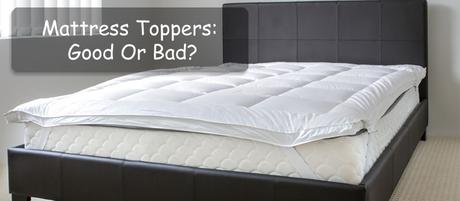Are mattress toppers good or bad to have on your bed? I will answer that question by explaining what a mattress topper is and where it should and should not be used. You will then be able to answer the question for yourself.

Fundamentally, a mattress topper is a thin pad or overlay that lies on top of your regular mattress. It can be anything from 1" to around 3" thick. It is generally intended to alter or refresh the top or sleeping surface of a mattress. Sometimes you may find your mattress to be too soft or too hard for you, and it is less expensive to use a mattress topper than to purchase a new mattress. Some people use a mattress topper as a means of extending the life of a mattress that has become uncomfortable to lie on.
Table of Contents
Are Mattress Toppers Good or Bad For You?
The question as to whether mattress toppers are good or bad for you is not always easy to answer. A lot depends on your reason for using the topper and what is meant by good or bad. There is little or no medical opinion on this matter, although most orthopedic mattress toppers are manufactured using polyurethane memory foam rather than latex. We shall discuss this by focusing on the following factors:
- Why people use mattress toppers?
- Different types of materials used in mattress topper - their pros and cons.
- The importance of thickness.
- Foam density.
1. Why do People Use Mattress Toppers?
If your existing mattress is too firm or hard for you it can hurt your back, neck or various pressure points such as your shoulders and hips. Changing your mattress can be expensive, particularly when compared to the price of the topper. Many people use a soft mattress topper to provide a more comfortable surface to a hard mattress. When used in this way, the new top layer can be a good thing. It can relieve pressure on your hips and shoulders and can help your spine rest with a more natural curvature. This, in turn, helps to reduce back pain.
However, if you have a mattress that is too soft for you, the opposite need not necessarily apply. Those who use a hard topper on a soft mattress often find that they do not get the additional support they need. Core support comes from within a mattress, not from the top layer. A high-density or hard latex foam core can provide support, as can coil springs. If your core support is too soft or worn, then it is highly unlikely that a mattress topper, no matter how firm, will give you the result you want. In such cases, a mattress topper is a bad thing.
The same is true if you have an old, worn mattress. Perhaps it has become too soft or has become lumpy and you find it difficult to sleep well. Sure, you can temporarily improve the sleeping surface using a mattress topper or pad, but you would be better to purchase a new mattress. Here are some of the more common types of mattress topper along with comments on their good and bad features.
2. Materials Used in Mattress Toppers
There are four main materials used in mattress toppers, each having their own positive and negative attributes. These are:
a) Memory Foam
Also known as visco-elastic foam, memory foam is the most popular type of topper. It relaxes where your body is in most contact with it, and also softens with your natural body heat. It 'memorizes' your natural body shape and maintains that shape while you sleep.
- Pros: Those with back pain can often get relief by using a memory foam topper that supports their body's pressure points and helps to keep their spine correctly supported. Many people choose a memory foam mattress topper just to experience the 'memory foam effect'. They may have an innerspring or latex foam mattress, but have heard or read about the benefits of memory foam and want to experience it. A gel memory foam contains particles containing a gel which absorbs the heat of your body to make the gel more liquid. This can reduce the heating effect mentioned below that is associated with memory foams.
- Cons: Memory foam can heat up while you sleep, and you can wake up feeling too hot. The foam absorbs your body heat to enable it to soften and contour to your body's shape. However, this heat tends to be retained - unless you use a gel memory foam. Another negative is that some people feel 'entrapped' by the foam they sink into - although this is less of an issue with the thinner pads than it is with mattresses made using 100% memory foam. This type of mattress topper can be difficult to flip.
- Good or Bad: So are memory foam mattress toppers good or bad for such people? Definitely good in the vast majority of cases!
b) Latex Foam Mattress Toppers
Latex foam is made using the milky excretion of the rubber plant. This can be converted into a foam by one of two methods: Dunlop or Talalay. Talalay foam contains more air and is softer than the more solid Dunlop latex foam.
Latex foam mattress toppers can also support those parts of your body that need support while you are sleeping. It is a resilient foam and can absorb much of the pressure on your hips and shoulders while you sleep on your side. Back sleepers get good buttock and shoulder support. A hard latex foam topper is probably not good for tummy sleepers.
- Pros: Latex foam also conforms to your body shape, but not in the same effective way as memory foam. Like memory foam, it can isolate the movement of a partner sharing the mattress, but not as effectively.
- Cons: Latex foam does not conform to your body in the same way as a memory foam does. However, a soft Talalay latex pad can be used to effectively soften up a mattress that feels too hard for you.
- Good or Bad: Latex foam mattress toppers made using the Talalay process can provide you with a soft sleeping surface. While Talalay latex is good for a soft mattress topper Dunlop, latex is harder. However, it is not hard enough to make up for too soft a sleeping surface on your existing mattress. A Talalay foam mattress can be good, while a Dunlop topper may be bad depending on the effect you are looking for.
C) Natural Down and Feather
Many people love the feeling of a natural down and feather mattress topper. If you have a mattress with the hard central core to provide you with maximum support, then you may find the top layers too firm for you. This is not always the case, but it can happen. Rather than use a foam topper, you may prefer the luxury of a down and feather mattress topper. This is a more popular type of mattress pad or topper than many believe it to be. The feathers provide bulk to the pad, while the down (soft, light feathers from the bird's breast) offers an extra-soft surface for you to sleep on.
- Pros: Very soft and luxurious sleeping surface.
- Cons: The down and feathers are natural and can affect those prone to allergies. This is a type of filling that is popular with some people and is very soft, although it can be costly and offers a considerably higher allergy risk than those above.
- Good or Bad: Good if you just want comfort, but very bad if you suffer allergies.
D) Synthetic Fiber Fillings
Synthetic fiber mattress toppers are made using synthetic fibers that can vary widely in their thickness. The thicker the fibers used that more dense and firmer the mattress topper. Thin microfibers will offer a soft, comfortable sleeping surface. Hollow fibers will provide more support. There is a range of firmness offered by this type of synthetic fiber, and it is important to check the hardness/firmness rating of such mattress toppers before purchasing them.
- Pros: You can choose between soft and firm sleeping surfaces, but make sure you understand the terms used. It is sometimes possible to rejuvenate an old mattress using this type of mattress topper.
- Cons: It is easy to order the wrong level of hardness.
- Good or Bad: I am neutral on this. It could be that you can find a mattress topper with a synthetic fiber filling that meets your needs exactly. However, it is important to get it right first time unless you find a vendor willing to change the mattress topper it if it does not suit you.
3. Importance of Thickness
While the type of filling for mattress toppers is very important, so too is their thickness. It should be fairly obvious that a one-inch thick topper will have less of an effect than a three-inch thick equivalent. Let's take a memory foam mattress topper as an example and discuss the effect of thickness of the foam:
2-inch Memory Foam Topper:
This may be sufficient for you if you are of small to medium build and weight. The support will be minimal, but still good enough to reduce pressure on your pressure points while you sleep. This is a good inexpensive starter if you want to experience the effect of sleeping on a memory foam surface.
3-Inch Memory Foam Mattress Topper:
This is the most popular thickness of a memory foam mattress topper. It proves a really comfortable sleeping surface on top of too firm of a mattress for you. The 3-inch thickness is enough to provide good pressure relief if you suffer joint or back pain. It's a good introduction to the memory foam concept.
4-Inch memory Foam Layer:
Great for camping outdoors where you don't have a regular bed and have to sleep on the ground. The 4-inch thick memory foam layer is good for heavier people - 250 pounds (113 Kg or over) - to place over their mattress at home. If you have steadily been putting on weight, and finding your mattress beginning to fail to support you comfortably, then this could be a great alternative to buying a new mattress.
4. Foam Density
Foam density is another important metric. As an example, if you need pressure relief on your back, hips, shoulders or other pressure points at night, then the density of the foam is just as important as its thickness. Take visco-elastic foam (aka memory foam). If you are looking for your mattress topper to help you with back pain, then you should be looking for a 3-inch memory foam with a density of between 4 and 5 pounds.
However, response time is also important so you should try the mattress topper before purchasing it. How quickly does the topper respond to your weight? If you take all of the above points into consideration when buying your mattress topper then you should get the right one.
Mattress Toppers Good or Bad - Conclusion
So: mattress toppers good or bad: They are good if you take the time to learn about them. What are they intended for? What are they made from? What properties should you be looking for in your mattress topper?
Learn all of this then you will likely make the best purchasing decision for a person of your size, your weight and most importantly: your reason for buying one. Mattress toppers - good or bad? That depends on why you are buying one and how you use it!

